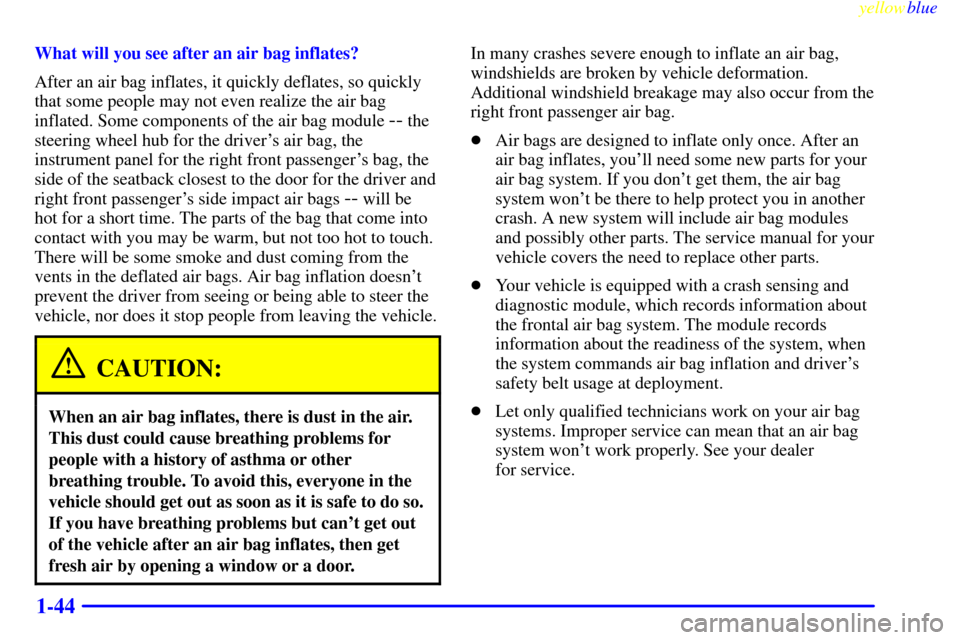Page 34 of 440
yellowblue
1-26
or the instrument panel ...or the safety belts!
With safety belts, you slow down as the vehicle does.
You get more time to stop. You stop over more distance,
and your strongest bones take the forces. That's why
safety belts make such good sense.
Page 48 of 440
yellowblue
1-40
There is an air bag readiness
light on the instrument
panel, which shows a
deployed air bag.
The system checks the air bag electrical system for
malfunctions. The light tells you if there is an electrical
problem. See ªAir Bag Readiness Lightº in the Index
for more information.How the Air Bag Systems Work
Where are the air bags?
The driver's frontal air bag is in the middle of the
steering wheel.
Page 49 of 440
yellowblue
1-41
The right front passenger's frontal air bag is in the
instrument panel on the passenger's side.The driver's side impact air bag is in the side of the
driver's seatback closest to the door.
The right front passenger's side impact air bag is in the
side of the passenger's seatback closest to the door.
Page 51 of 440

yellowblue
1-43
In any particular crash, no one can say whether an air
bag should have inflated simply because of the damage
to a vehicle or because of what the repair costs were. For
frontal air bags, inflation is determined by the angle of
the impact and how quickly the vehicle slows down in
frontal and near
-frontal impacts. For side impact air
bags, inflation is determined by the location of the
impact and how quickly the side of the vehicle deforms.
What makes an air bag inflate?
In an impact of sufficient severity, the air bag sensing
system detects that the vehicle is in a crash. For both
frontal and side impact air bags, the sensing system
triggers a release of gas from the inflator, which inflates
the air bag. The inflator, air bag and related hardware
are all part of the air bag modules inside the steering
wheel, instrument panel and the side of the front
seatbacks closest to the door.How does an air bag restrain?
In moderate to severe frontal or near frontal collisions,
even belted occupants can contact the steering wheel or
the instrument panel. In moderate to severe side
collisions, even belted occupants can contact the inside
of the vehicle. The air bag supplements the protection
provided by safety belts. Air bags distribute the force of
the impact more evenly over the occupant's upper body,
stopping the occupant more gradually. But the frontal air
bags would not help you in many types of collisions,
including rollovers, rear impacts, and side impacts,
primarily because an occupant's motion is not toward
the air bag. Side impact air bags would not help you in
many types of collisions, including frontal or near
frontal collisions, rollovers, and rear impacts, primarily
because an occupant's motion is not toward those air
bags. Air bags should never be regarded as anything
more than a supplement to safety belts, and then only in
moderate to severe frontal or near
-frontal collisions for
the driver's and right front passenger's frontal air bags,
and only in moderate to severe side collisions for the
driver's and right front passenger's side impact air bags.
Page 52 of 440

yellowblue
1-44
What will you see after an air bag inflates?
After an air bag inflates, it quickly deflates, so quickly
that some people may not even realize the air bag
inflated. Some components of the air bag module
-- the
steering wheel hub for the driver's air bag, the
instrument panel for the right front passenger's bag, the
side of the seatback closest to the door for the driver and
right front passenger's side impact air bags
-- will be
hot for a short time. The parts of the bag that come into
contact with you may be warm, but not too hot to touch.
There will be some smoke and dust coming from the
vents in the deflated air bags. Air bag inflation doesn't
prevent the driver from seeing or being able to steer the
vehicle, nor does it stop people from leaving the vehicle.
CAUTION:
When an air bag inflates, there is dust in the air.
This dust could cause breathing problems for
people with a history of asthma or other
breathing trouble. To avoid this, everyone in the
vehicle should get out as soon as it is safe to do so.
If you have breathing problems but can't get out
of the vehicle after an air bag inflates, then get
fresh air by opening a window or a door.
In many crashes severe enough to inflate an air bag,
windshields are broken by vehicle deformation.
Additional windshield breakage may also occur from the
right front passenger air bag.
�Air bags are designed to inflate only once. After an
air bag inflates, you'll need some new parts for your
air bag system. If you don't get them, the air bag
system won't be there to help protect you in another
crash. A new system will include air bag modules
and possibly other parts. The service manual for your
vehicle covers the need to replace other parts.
�Your vehicle is equipped with a crash sensing and
diagnostic module, which records information about
the frontal air bag system. The module records
information about the readiness of the system, when
the system commands air bag inflation and driver's
safety belt usage at deployment.
�Let only qualified technicians work on your air bag
systems. Improper service can mean that an air bag
system won't work properly. See your dealer
for service.
Page 53 of 440

yellowblue
1-45
NOTICE:
If you damage the covering for the driver's or the
right front passenger's air bag, or the air bag
covering on the driver's and right front
passenger's seatback, the bag may not work
properly. You may have to replace the air bag
module in the steering wheel, both the air bag
module and the instrument panel for the right
front passenger's air bag, or both the air bag
module and seatback for the driver's and right
front passenger's side impact air bag. Do not
open or break the air bag coverings.
If your vehicle ever gets into a lot of water -- such as
water up to the carpeting or higher
-- or if water enters
your vehicle and soaks the carpet, the air bag controller
can be soaked and ruined. If this ever happens, and then
you start your vehicle, the damage could make the
frontal and side impact air bags inflate and safety belt
pretensioners activate, even if there's no crash. You
would have to replace the air bags, all the sensors and
related parts, parts of the safety belt system and parts of
the driver and right front passenger's seatbacks. If your
vehicle is ever in a flood, or if it's exposed to water that
soaks the carpet, you can avoid needless repair costs by
turning off the vehicle immediately and disconnecting
the battery cables. Don't let anyone start the vehicle
under any circumstances. See your dealer for service.
Servicing Your Air Bag-Equipped Vehicle
Air bags affect how your vehicle should be serviced.
There are parts of the air bag systems in several places
around your vehicle. Your dealer and the service manual
have information about servicing your vehicle and the
air bag systems. To purchase a service manual, see
ªService and Owner Publicationsº in the Index.
Page 101 of 440

2-
yellowblue
2-1
Section 2 Features and Controls
Here you can learn about the many standard and optional features on your vehicle, and information on starting,
shifting and braking. Also explained are the instrument panel and the warning systems that tell you if everything is
working properly
-- and what to do if you have a problem.
2
-2 Keys
2
-4 Door Locks
2
-7 Keyless Entry System (Option)
2
-13 Multifunction Alarm Locks and
Lighting Choices
2
-23 Sliding Door
2
-25 Power Sliding Door (Option)
2
-31 Liftgate
2
-32 Theft
2
-33 Content Theft-Deterrent (Option)
2
-35 PASS-Key� III
2
-37 New Vehicle ªBreak-Inº
2
-38 Ignition Positions
2
-40 Starting Your Engine
2
-41 Engine Coolant Heater (If Equipped)
2
-43 Automatic Transaxle Operation
2
-47 Parking Brake
2
-48 Shifting Into PARK (P)2
-50 Shifting Out of PARK (P)
2
-51 Parking Over Things That Burn
2
-52 Engine Exhaust
2
-52 Running Your Engine While You're Parked
2
-53 Windows
2
-55 Turn Signal/Multifunction Lever
2
-61 Exterior Lamps
2
-63 Interior Lamps
2
-66 Mirrors
2
-68 Storage Compartments
2
-79 Sun Visors
2
-80 OnStar System� (Option)
2
-80 Accessory Inflator System (Option)
2
-83 Accessory Power Outlets
2
-84 The Instrument Panel -- Your
Information System
2
-88 Warning Lights, Gages and Indicators
2
-102 Driver Information Center (DIC) (Option)
Page 112 of 440

yellowblue
2-12Switchbanks
There are two sets of switchbanks located in the front of the
vehicle. The switches will vary with the options that are on
your vehicle. It is useful to become familiar with them since
they are used frequently while operating the vehicle.
Overhead Console Switchbank
This switchbank is located in the overhead console. The
switches that you may find in this switchbank are the
Interior Lights Override, Power Sliding Door and the
Power Rear Quarter Windows. If your vehicle does not
have some of the options controlled by these switches,
there will be a blank button in its place.
For more information, please see each of these features
in the Index.
Instrument Panel Switchbank
This switchbank is located in the instrument panel below
the comfort controls. The switches and controls that you
may find in this switchbank are the Rear Fan Knob,
Rear Window Wiper/Washer and Traction Control. If
your vehicle does not have some of the options
controlled by these switches, there will be a blank button
in its place.
For more information, please see each of these features
in the Index.
If your vehicle is not equipped with the optional rear
climate control system, there will be a storage space in
this switchbank. The rubber mat can be removed for
cleaning. Snap the mat into place after cleaning.